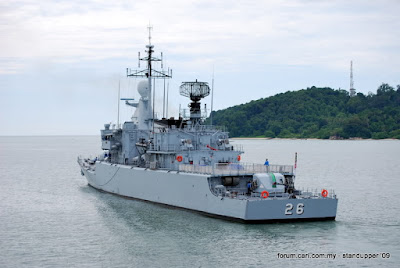Some Assets of Royal Malaysian Navy will be Decommissioned
07 Oktober 2016

KD Hang Tuah training ship (photo : jiayuan)
Hang Tuah, Laksamana-class, LMS and Helos too
SHAH ALAM: KD Hang Tuah, the grand dame of the Royal Malaysian Navy will be paid-off when the two DSME-designed training ships are commissioned.
The first training ship, Gagah Samudera is expected to be commissioned by November while the second ship, Teguh Samudera is expected to receive its pennant, next year.
RMN chief Admiral Ahmad Kamarulzaman Badaruddin said the four Laksamana-class corvettes will be decommissioned – most likely one at a time – when the first four units of the Littoral Mission Ships (LMS) are commissioned, also one at a time.
He did not specify the timeline for the decommissioning or the commissioning, however. Hang Tuah will be preserved as a floating museum though the location has not been decided.
Asked why Hang Tuah and Laksamana-class were to be retired ahead of the much-older Sandakan-based patrol craft – KD Seri Perlis and KD Seri Johor, Kamarulzaman said the five ships were chosen based on the number of days they spend at sea and the cost to maintain them.

Laksamana class corvette (photo : Shephard)
“Based on those criterias, Hang Tuah will be the first to go and the Laksamanas the next. After that it will be the MCMVs turn,” he says in an interview after presenting the keynote address at the Maritime Warfare Asia 2016 on Wednesday.
Kamarulzaman also said that an announcement on the RMN 15-to-5 plan will be made during the presentation of the 2017 Budget, scheduled to be delivered by the Finance Minister by the end of this month.
Pressed on what will be announced, Kamarulzaman declined to comment further saying that “you will have to wait for the budget presentation.
Asked whether the announcement will be about RMN ordering China-made warships – corvettes or the LMS – Kamarulzaman declined to be specific although he said that the service had no objections in getting them as long it fit “RMN requirements and missions.”
On the LMS, Kamarulzaman confirmed that the plan was to buy 18 of these vessels. RMN, according to him, is speaking with shipyards to get their proposals for the class. He said the LMS will replaced various vessels in the navy including the MCMVs.

KD Kasturi frigate (photo : standupper)
As for future mine hunting, Kamarulzaman said that they might used containerised mission modules for the capabiliy. He did not specify the numbers of modules to be procured or the capability to be acquired.
Kamarulzaman declined to outline the exact specifications of LMS apart from that it will be “70ish (metre) long”. It will be fitted for UAVs and probably USVs.
“We want to move away from laying specifications as in the past. When we do that – when my planning officers go to exhibitions and similar events – they will come back with a lot of data and we end up with a gold plated ship.
For the LMS our priority are the mission capabilities, that is why we called them (littoral) mission ships. It will not be our main surface combatants, that is the job of the LCS, the LMS will be used for border security, patrol and similar operations.

For border patrol or preventing illegal fishing, we do not need for example, jamming capabilities. However we might opt for “Fitted for but Not Equipped With” concept so we can reduce the purchase price.”
Asked on whether missiles and guns will be fitted on the LMS, Kamarulzaman said it will be based the proposals by the shipyards.
He also declined to specify the cost of the LMS as envisioned by the navy apart from saying it will be 80 per cent cheaper than the LCS. Industry sources however told Malaysian Defence that the cost has been capped to RM200 million per ship inclusive of the all the weapons.
One source says only China will be able to sell such a vessel at that price.
Meanwhile, Kamarulzaman said they want six newly built helicopters instead of just upgrading the six Super Lynxes already in service.

“The cost of upgrading the Super Lynxes is as much as buying new ones, so might as well we buy new ones. We have learn our lessons from the Kasturi upgrade. We end up paying two-thirds of the cost of buying a new ship,” he added.
As for the LCS, he said as off, Oct 1, the progress is up to 28 percent. It was expected that the ship will be launched by March or April, next year and Kamarulzaman said they were still targeting 2019 for its commissioning.
He admitted that it was cheaper and faster to built the ships in France but the RMN accepted the government’s decision to built them locally . The decision have a great impact on the local defence industry and the community.
(
Malaysian Defence)





 Image via suanie.net
Image via suanie.net Image via The Star
Image via The Star Image via Suanie.net
Image via Suanie.net Image via apanama
Image via apanama Image via apanama
Image via apanama Image via apanama
Image via apanama
 Image via metrio The Nehemiah walls are more durable and faster to build compared to rigid concrete blocks.
Image via metrio The Nehemiah walls are more durable and faster to build compared to rigid concrete blocks. Image via ChristianityMalaysia
Image via ChristianityMalaysia Image via hubhomedesign
Image via hubhomedesign Image via kevinthom
Image via kevinthom Image via Wired
Image via Wired Image via digitaltrends
Image via digitaltrends
 Image via melakapages
Image via melakapages Image via Macri Malaysia via Facebook
Image via Macri Malaysia via Facebook Image via Macri Malaysia via Facebook
Image via Macri Malaysia via Facebook Image via accessorygeeks
Image via accessorygeeks Image via Macri Malaysia via Facebook
Image via Macri Malaysia via Facebook
 Image via opensercurity
Image via opensercurity Image via putriariana
Image via putriariana Image via sweetwiskies
Image via sweetwiskies Image via BBC
Image via BBC Image via theguardian
Image via theguardian Image via BBC
Image via BBC














